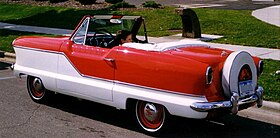Nash Metropolitan
| Metropolitan | |
|---|---|

1957 Metropolitan
|
|
| Overview | |
| Manufacturer | Austin (BMC) |
| Also called |
Hudson Metropolitan Metropolitan by American Motors Austin Metropolitan |
| Production | October 1953–April 1961 (1954-1962 model years) |
| Assembly | Longbridge, Birmingham, West Midlands, England |
| Designer | William J. Flajole |
| Body and chassis | |
| Class |
Economy car Subcompact car |
| Body style | 2-door hardtop 2-door convertible |
| Layout | FR layout |
| Powertrain | |
| Engine | 1,200 cc (1.2 L) Austin A40 I4 1,500 cc (1.5 L) B-Series I4 |
| Transmission | 3-speed manual |
| Dimensions | |
| Wheelbase | 85 in (2,159 mm) |
| Length | 149.5 in (3,797 mm) |
| Width | 61.5 in (1,562 mm) |
| Height | 54.5 in (1,384 mm) |
| Curb weight | 1,785 lb (810 kg) (base) |
| Series I | |
|---|---|
 |
|
| Overview | |
| Production | 1953 |
| Series II | |
|---|---|
 |
|
| Overview | |
| Production | 1955 |
| Series III | |
|---|---|
 |
|
| Overview | |
| Production | 1955–58 |
| Series IV | |
|---|---|
 |
|
| Overview | |
| Production | 1959–61 |
The Nash Metropolitan was an American automobile that was sold from 1953 to 1961.
It conforms to two classes of vehicle: economy car and subcompact car. In today’s terminology the Metropolitan is a “subcompact”, but this category had not yet come into use when the car was made. At that time, it was variously categorized, for example as a "small automobile" as well as an "economy car".
The Metropolitan was also sold as a Hudson when Nash and Hudson merged in 1954 to form the American Motors Corporation (AMC), and later as a standalone marque during the Rambler years, as well as in the United Kingdom and other markets.
While most U.S. automobile makers were following a "bigger-is-better" philosophy, Nash Motor Company executives were examining the market to offer American buyers an economical transportation alternative. The Metropolitan was designed in the U.S. and it was patterned from a concept car, the NXI (Nash Experimental International), that was built by Detroit-based independent designer William J. Flajole for Nash-Kelvinator. It was designed as the second car in a two car family, for Mom taking the kids to school or shopping or for Dad to drive to the railroad station to ride to work: the "commuter/shopping car" with resemblance to the big Nash, but the scale was tiny as the Met's wheelbase was shorter than the Volkswagen Beetle's.
The NXI design study incorporated many innovative features, and attempted to make use of interchangeable front and rear components (the symmetrical door skins were the only interchangeable items that made it into production). Although more complex, the new vehicle also incorporated Nash's advanced single-unit (monocoque) construction. It was displayed at a number of "surviews" (survey/previews), commencing on 4 January 1950 at the Waldorf-Astoria Hotel, New York, to gauge the reaction of the American motoring public to a car of this size. The result of these surviews convinced Nash that there was indeed a market for such a car, if it could be built at a competitive price.
...
Wikipedia
